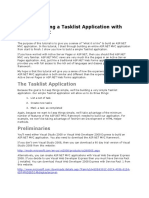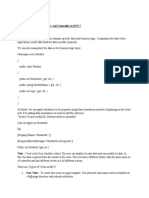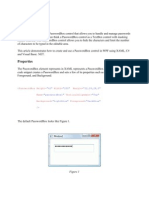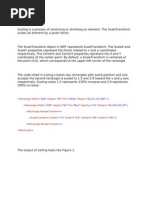Aspnet MVC Tutorial 03 Cs PDF
Uploaded by
AbhiAspnet MVC Tutorial 03 Cs PDF
Uploaded by
AbhiMVC :: Understanding Controllers, Controller Actions, and Action Results
This tutorial explores the topic of ASP.NET MVC controllers, controller actions, and action results. After you complete this tutorial, you will understand how controllers are used to control the way a visitor interacts with an ASP.NET MVC website.
Understanding Controllers
MVC controllers are responsible for responding to requests made against an ASP.NET MVC website. Each browser request is mapped to a particular controller. For example, imagine that you enter the following URL into the address bar of your browser: http://localhost/Product/Index/3 In this case, a controller named ProductController is invoked. The ProductController is responsible for generating the response to the browser request. For example, the controller might return a particular view back to the browser or the controller might redirect the user to another controller. You create a new controller by adding a new controller to your ASP.NET MVC applications Controllers folder. Right-click the Controllers folder and select the menu option Add, New Item and select the MVC Controller Class template (see Figure 1). A controller name must include the suffix Controller. For example, the controller name ProductController is fine but the controller name Product wont work.
Figure 1 Creating a new Controller
If you create a new controller named ProductController then you will get the file in Listing 1. Listing1 ProductController.cs using System; using System.Collections.Generic; using System.Linq; using System.Web; using System.Web.Mvc;
namespace MvcApp.Controllers { public class ProductController : Controller { public ActionResult Index() { // Add action logic here throw new NotImplementedException(); } } }
As you can see from Listing 1, a controller is just a class (a Visual Basic .NET or C# class). A controller is a class that derives from the base System.Web.Mvc.Controller class. Because a controller inherits from this base class, a controller inherits several useful methods for free (We discuss these methods in a moment).
Understanding Controller Actions
A controller exposes controller actions. An action is a method on a controller that gets called when you enter a particular URL in your browser address bar. For example, imagine that you make a request for the following URL: http://localhost/Product/Index/3 In this case, the Index() method is called on the ProductController class. The Index() method is an example of a controller action. A controller action must be a public method of a controller class. C# methods, by default, are private methods. Realize that any public method that you add to a controller class is
exposed as a controller action automatically (You must be careful about this since a controller action can be invoked by anyone in the universe simply by typing the right URL into a browser address bar). There are some additional requirements that must be satisfied by a controller action. A method used as a controller action cannot be overloaded. Furthermore, a controller action cannot be a static method. Other than that, you can use just about any method as a controller action.
Understanding Action Results
A controller action returns something called an action result. An action result is what a controller action returns in response to a browser request. The ASP.NET MVC framework supports six standard types of action results: 1. ViewResult Represents HTML and markup. 2. EmptyResult Represents no result. 3. RedirectResult Represents a redirection to a new URL. 4. RedirectToRouteResult Represents a redirection to a new controller action. 5. JsonResult Represents a JavaScript Object Notation result that can be used in an AJAX application. 6. ContentResult Represents a text result. All of these action results inherit from the base ActionResult class. In most cases, a controller action returns a ViewResult. For example, the Index controller action in Listing 2 returns a ViewResult. Listing 2 BookController.cs using System; using System.Collections.Generic; using System.Linq; using System.Web; using System.Web.Mvc;
namespace MvcApp.Controllers { public class BookController : Controller { public ActionResult Index() { return View(); }
} }
When an action returns a ViewResult, HTML is returned to the browser. The Index() method in Listing 2 returns a view named Index.aspx to the browser. Notice that the Index() action in Listing 2 does not return a ViewResult(). Instead, the View() method of the Controller base class is called. Normally, you do not return an action result directly. Instead, you call one of the following methods of the Controller base class: 1. View Returns a ViewResult action result. 2. Redirect Returns a RedirectResult action result. 3. RedirectToAction Returns a RedirectToRouteResult action result. 4. RedirectToRoute Returns a RedirectToRouteResult action result. 5. Json Returns a JsonResult action result. 6. Content Returns a ContentResult action result. So, if you want to return a View to the browser, you call the View() method. If you want to redirect the user from one controller action to another, you call the RedirectToAction() method. For example, the Details() action in Listing 3 either displays a view or redirects the user to the Index() action depending on whether the Id parameter has a value. Listing 3 CustomerController.cs using System; using System.Collections.Generic; using System.Linq; using System.Web; using System.Web.Mvc;
namespace MvcApp.Controllers { public class CustomerController : Controller {
public ActionResult Details(int? Id) { if (Id == null) return RedirectToAction("Index"); return View(); }
public ActionResult Index() { return View(); }
} }
The ContentResult action result is special. You can use the ContentResult action result to return an action result as plain text. For example, the Index() method in Listing 4 returns a message as plain text and not as HTML. Listing 4 StatusController.cs using System; using System.Collections.Generic; using System.Linq; using System.Web; using System.Web.Mvc;
namespace MvcApp.Controllers { public class StatusController : Controller { public ContentResult Index() { return Content("Hello World!"); } } }
When the StatusController.Index() action is invoked, a view is not returned. Instead, the raw text Hello World! is returned to the browser. If a controller action returns a result that is not an action result for example, a date or an integer then the result is wrapped in a ContentResult automatically. For example, when the Index() action of the WorkController in Listing 5 is invoked, the date is returned as a ContentResult automatically.
Listing 5 WorkController.cs using System; using System.Collections.Generic; using System.Linq; using System.Web; using System.Web.Mvc;
namespace MvcApp.Controllers { public class WorkController : Controller { public DateTime Index() { return DateTime.Now; } } }
The Index() action in Listing 5 returns a DateTime object. The ASP.NET MVC framework converts the DateTime object to a string and wraps the DateTime value in a ContentResult automatically. The browser receives the date and time as plain text.
Summary
The purpose of this tutorial was to introduce you to the concepts of ASP.NET MVC controllers, controller actions, and controller action results. In the first section, you learned how to add new controllers to an ASP.NET MVC project. Next, you learned how public methods of a controller are exposed to the universe as controller actions. Finally, we discussed the different types of action results that can be returned from a controller action. In particular, we discussed how to return a ViewResult, RedirectToActionResult, and ContentResult from a controller action.
You might also like
- Nterprise Pplication Evelopment: Resource Person: Noor Ullah Khan Email: Noorkhan@uoslahore - Edu.pkNo ratings yetNterprise Pplication Evelopment: Resource Person: Noor Ullah Khan Email: Noorkhan@uoslahore - Edu.pk10 pages
- Unit 4_46f7dde2-35bb-4bef-9fe3-adab3c0cd6deNo ratings yetUnit 4_46f7dde2-35bb-4bef-9fe3-adab3c0cd6de81 pages
- MVC:: Creating A Tasklist Application WithNo ratings yetMVC:: Creating A Tasklist Application With16 pages
- Most Asked ASP - Net MVC Interview Questions and Answers C Sharp CornerNo ratings yetMost Asked ASP - Net MVC Interview Questions and Answers C Sharp Corner39 pages
- Spring Boot Intermediate Microservices: Resilient Microservices with Spring Boot 2 and Spring CloudFrom EverandSpring Boot Intermediate Microservices: Resilient Microservices with Spring Boot 2 and Spring CloudNo ratings yet
- 7_lecture 3 - Getting Started With ASP Net CoreNo ratings yet7_lecture 3 - Getting Started With ASP Net Core87 pages
- Can You Explain Model, View, and Controller in MVC?No ratings yetCan You Explain Model, View, and Controller in MVC?39 pages
- Lesson 1: Overview of Microsoft Web TechnologiesNo ratings yetLesson 1: Overview of Microsoft Web Technologies22 pages
- Download Complete Programming Microsoft ASP NET MVC 2nd Edition Dino Esposito PDF for All ChaptersNo ratings yetDownload Complete Programming Microsoft ASP NET MVC 2nd Edition Dino Esposito PDF for All Chapters51 pages
- Getting Started With MVC 5 and Visual Studio 2013: @trobbinsNo ratings yetGetting Started With MVC 5 and Visual Studio 2013: @trobbins40 pages
- Programming Microsoft ASP NET MVC 2nd Edition Dino Esposito downloadNo ratings yetProgramming Microsoft ASP NET MVC 2nd Edition Dino Esposito download65 pages
- Programming Microsoft ASP NET MVC 2nd Edition Dino Esposito - Download the ebook today and own the complete version100% (1)Programming Microsoft ASP NET MVC 2nd Edition Dino Esposito - Download the ebook today and own the complete version55 pages
- Aspnet Batch-8 Interview Preparation QNANo ratings yetAspnet Batch-8 Interview Preparation QNA40 pages
- Routing, Controllers, Acti Ons, Views, Areas : Softuni TeamNo ratings yetRouting, Controllers, Acti Ons, Views, Areas : Softuni Team53 pages
- The Art of WebAssembly: Build Secure, Portable, High-Performance ApplicationsFrom EverandThe Art of WebAssembly: Build Secure, Portable, High-Performance ApplicationsNo ratings yet
- Concept and Basics: It19 - Advance ProgrammingNo ratings yetConcept and Basics: It19 - Advance Programming38 pages
- Explain MVC (Model-View-Controller) in General?No ratings yetExplain MVC (Model-View-Controller) in General?195 pages
- Developing and Deploying Custom Web2007No ratings yetDeveloping and Deploying Custom Web200714 pages
- Using IComparer IComparable For Sorting in WPFNo ratings yetUsing IComparer IComparable For Sorting in WPF6 pages
- Show Delete Edit Data WPF DataGrid LINQ SQL ClassesNo ratings yetShow Delete Edit Data WPF DataGrid LINQ SQL Classes7 pages
- CMR College of Engineering and Technology: Kandlyakoya, HyderabadNo ratings yetCMR College of Engineering and Technology: Kandlyakoya, Hyderabad3 pages
- Getting Started With Oracle BI Publisher 11gNo ratings yetGetting Started With Oracle BI Publisher 11g76 pages
- How To Sniff Wireless Packets With Wireshark50% (2)How To Sniff Wireless Packets With Wireshark3 pages
- Software Architecture Analysis Method (SAAM)No ratings yetSoftware Architecture Analysis Method (SAAM)9 pages
- Donald Smith Devices Too Good To Be TrueNo ratings yetDonald Smith Devices Too Good To Be True16 pages
- Routeurs Cisco, Mise en Œuvre de BGP: 1) Introduction Au Protocole BGPNo ratings yetRouteurs Cisco, Mise en Œuvre de BGP: 1) Introduction Au Protocole BGP2 pages
- SFXtools Bot Weapons WAV-FANTASTiC AudioZNo ratings yetSFXtools Bot Weapons WAV-FANTASTiC AudioZ5 pages
- Chapter 5. TeleCommunication and NetworkingNo ratings yetChapter 5. TeleCommunication and Networking37 pages
- How To - Install Windows 7 From A USB Key! - Maximum PCNo ratings yetHow To - Install Windows 7 From A USB Key! - Maximum PC12 pages

















































































































